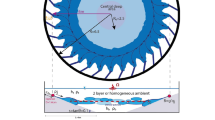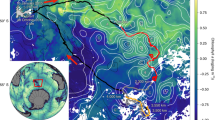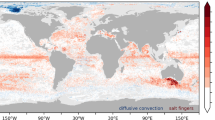Abstract
A MAJOR task of physical oceanography is the determination of the fluxes of heat and salt and the identification of the processes responsible for producing the fluxes. For the development of realistic models of the ocean it is particularly important that fluxes across surfaces of constant density (isopycnal surfaces) be distinguished from those along isopycnals. We report here direct evidence that at least some of the 5–20-m thick intrusions commonly found in regions of strong horizontal variability (fronts) lie across isopycnals. The intrusions are formed by primarily lateral advection to produce complicated interleavings of the differing types of water across the fronts. The ubiquitous occurrence of intrusions in frontal regions and the fact that they cross isopycnal surfaces indicates that they are important factors in the vertical, as well as the horizontal, flux budgets of heat and salt. The low levels of cross-isopycnal fluxes due to small scale turbulence away from fronts1 further suggests that these intrusions may be important in the overall global flux budgets of heat and salt.
This is a preview of subscription content, access via your institution
Access options
Subscribe to this journal
Receive 51 print issues and online access
$199.00 per year
only $3.90 per issue
Buy this article
- Purchase on Springer Link
- Instant access to full article PDF
Prices may be subject to local taxes which are calculated during checkout
Similar content being viewed by others
References
Gregg, M. C. J. phys. Oceanogr. 7, 436 (1977).
Pederson, A. M. Trans. Mar. Technol. Soc. Mar. Temp. Measurements Symp. 135 (1969).
Pederson, A. M. & Gregg, M. C. I.E.E.E. J. of Oceanic Engng. (in the press).
Dantzler, H. L. Deep Sea Res. 21, 675 (1974).
Gregg, M. C. & Cox, C. S. Deep Sea Res. 19, 355 (1972).
Turner, J. S. Buoyancy Effects in Fluids (Cambridge University Press, 1973).
Turner, J. S. & Chen, C. F. J. Fluid Mech. 63, 577 (1974).
Joyce, T. M., Zenk, W. & Toole, J. M. J. geophys. Res. 83, 6093 (1978).
Author information
Authors and Affiliations
Rights and permissions
About this article
Cite this article
GREGG, M., MCKENZIE, J. Thermohaline intrusions lie across isopycnals. Nature 280, 310–311 (1979). https://doi.org/10.1038/280310a0
Received:
Accepted:
Issue Date:
DOI: https://doi.org/10.1038/280310a0
This article is cited by
Comments
By submitting a comment you agree to abide by our Terms and Community Guidelines. If you find something abusive or that does not comply with our terms or guidelines please flag it as inappropriate.



